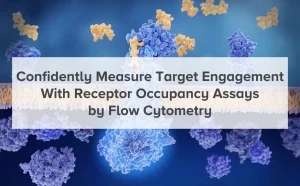September 17, 2024

A crucial step in the drug development process involves optimizing drug-target engagement for your biotherapeutic and gaining valuable pharmacodynamic biomarker data. High-quality receptor occupancy assays (RO assays) are vital tools in this process.
Reliable and accurate results in the design, development, and implementation of receptor occupancy assays can seem to be a tasking prospect, as they are prone to numerous technical and logistical challenges, requiring-
- expert assay design
- optimal matrix selection
- data normalization/reporting
- and rigorous quality control1, 2
Such challenges can escalate further in difficult development scenarios, such as when the target antigen is expressed at low levels, where there is receptor modulation, or when the therapeutic molecules are bi-specific and bind multiple targets2.
Types and Methodologies
RO assays can be classified into two main types: competitive assays and saturation assays. Competitive assays involve the use of competitive and non-competitive antibodies to the drug, to note that the competitive antibody can also be substituted by an anti-drug antibody. Saturation assays use a competitive antibody and the drug product itself detected by an antibody as a reference point.
| Type of Assay | Description |
|---|---|
| Competing vs. non-competing antibodies | Competing and non-competing antibodies are added to a sample. Competing antibodies bind to the drug's target site, indicating unbound targets. Non-competing antibodies bind elsewhere on the target, showing total available targets. Alternatively, the competing antibody can be substituted for a anti-drug antibody |
| Saturation assay | Half of the sample is saturated with the drug, mimicking 100% RO, showing the total number of available target sites. The other half remains unsaturated, reflecting drug binding in the patient. A secondary antibody detects the drug, this can be done using an anti-drug or an anti-Ig antibody, and the ratio of unsaturated to saturated samples reveals the drug's receptor occupancy (RO) level. |
Custom RO Strategies for Enhanced Drug Development
CellCarta’s flow-cytometry-based receptor occupancy (RO) assays are designed to overcome these challenges and accelerate your efforts, providing you with the critical information needed to demonstrate target engagement, and gain insight into what degree and how long your biotherapeutic binds its target.
Our RO assays can also be used to complement your pharmacokinetic profiling to provide valuable information on dose selection and frequency of drug infusion. Additionally, RO assays can be validated to support secondary endpoints.
One of our RO strategies starts with the identification of both a competitive and a non-competitive antibody. The competitive antibody will only bind to its target if it is not currently bound by the drug, allowing identification of free receptors, while the non-competitive antibody identifies the total amount of target receptors.
We monitor receptor occupancy only in cell populations of interest by combining target-specific reagents into a flow cytometry panel of phenotypic markers. Competitive and non-competitive antibodies can even be used in the same panel.
When competitive or non-competitive antibodies cannot be identified, or when antibodies to the receptor are not available, we use a saturating vs. non-saturating approach to determine the receptor occupancy or RO.
The strategy involves saturation of half of the sample, mimicking a 100% RO. The other half is not saturated, allowing us to perform a ratio of drug-binding between the two halves to accurately determine the receptor occupancy of the sample.
Pharmacokinetic and Pharmacodynamic Insights
RO assays are integrated with pharmacokinetic (PK) and pharmacodynamic (PD) models to inform dosing strategies and optimize drug efficacy. These assays help determine the relationship between drug concentration and its biological effect, providing critical data for dose selection and frequency of administration. This integration is particularly valuable in clinical trials, where RO assays can serve as pharmacodynamic biomarker measurements to assess drug efficacy.
Choosing the ideal sample matrix for accurate RO Assays
The choice of sample matrix can have a profound effect on the quality of a RO assay. For example, PBMC processing can negatively impact the binding of the drug, resulting in an underestimation of the RO. We also typically test different vacutainers to maximize the stability and precision of the RO measurement.
Our experienced scientists develop and validate different RO strategies to address a variety of drug types and reagent availabilities, drawing on our extensive experience in deploying RO assay strategies in clinical trials.
Challenges and Considerations
Despite their importance, RO assays present several challenges. The development and optimization of these assays are complex and demand high-quality reagents and rigorous controls. Additionally, interpreting the data can be complicated by factors such as receptor internalization and degradation, necessitating a thorough understanding of the underlying biological processes.
Emerging Trends and Technological Breakthroughs in Receptor Occupancy Assays
Advanced technologies and methodologies are continually enhancing the accuracy and reliability of RO assays. Complex RO assays can provide additional insights into receptor internalization and shedding, contributing to a more comprehensive understanding of drug-target interactions. These advancements hold the potential to revolutionize drug development by providing more precise and detailed pharmacodynamic data.
CellCarta exemplifies these advancements with state-of-the-art flow cytometry and custom panels that ensure precise measurements, even in complex scenarios. This accuracy is crucial for informing dose selection and optimizing therapeutic efficacy. Emerging technologies like single-cell RNA sequencing and high-dimensional flow cytometry promise even deeper insights into drug-receptor interactions.
Step Up to the Next Level in Your RO Assay Development and Validation
Enhance the robustness of your RO assay development with our custom-designed panels and expert guidance, ensuring accurate and reliable data that drives informed decision-making in your drug development process.
Expert Insights: Watch the following video from our expert to mastering receptor occupancy assays with Flow Cytometry
About the author:

Damien Montamat-Sicotte is a Scientific Business Director at CellCarta, specializing in the flow cytometry platform. With a PhD in immunology and post-doctoral expertise from various institutions, Damien has profuse experience in managing the processing and analysis of clinical samples by flow cytometry in an immune monitoring context.
References
- Liang M, Schwickart M, Schneider AK, et al. Receptor occupancy assessment by flow cytometry as a pharmacodynamic biomarker in biopharmaceutical development. Cytometry B Clin Cytom 2016;90:117-27.
- Hilt E, Sun YS, McCloskey TW, et al. Best practices for optimization and validation of flow cytometry-based receptor occupancy assays. Cytometry B Clin Cytom 2021;100:63-71.
You might also be interested by
CellTalk Blog
ELISpot vs. ICS: Optimizing Immune Monitoring in Clinical Trials with the Right Functional Assay
November 19, 2024
Immune Monitoring
More infoBrochures & Infographics
High Performance Technologies for Cytokine Measurement
July 29, 2024
Immune Monitoring
More infoBrochures & Infographics
Next-Generation Flow Cytometry Analysis with CellEngine™
January 31, 2023
Immune Monitoring
More info